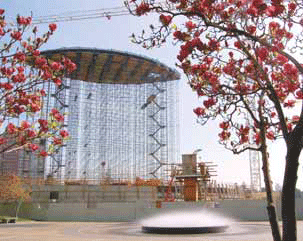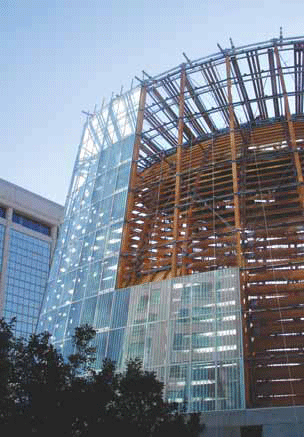
The new Cathedral of Christ the Light on the shores of Oakland’s Lake Merritt has been widely published. It has become one of the new landmarks that suggest that the Bay Area is no longer a backwater when it comes to striking contemporary design. Kenneth Caldwell had a conversation with the building’s lead designer, Craig Hartman, FAIA, of SOM, and Rev. Paul Minnihan, who served as provost of the new Cathedral during much of the process, about how the bold form came together and what it represents. We met in a conference room at SOM overlooking downtown San Francisco.
arcCA: When did you start working together?
Minnihan: We first talked about the cathedral in 2006 when I was pastor of a parish in Moraga.Craig came out with others to share this vision. Initially there was a lot of concern: “Why are we building this?” I jokingly said, “I am cold on cool architecture.” Shortly after that, I got a call from Archbishop Vigneron, then Bishop of Oakland, and he said, “I’d like you to become provost of the cathedral.” And my response was, “What does that mean?” It came down to working hand in hand with our leadership, the diocese, Craig, and SOM to create the best synergy possible.
arcCA: So what changed in your approach?
Minnihan: If you consider life as being about learning to learn, it was a matter of my coming in to this very room to sit down, listen, and reserve all my opinions.

Hartman: Among the most important ideas was that the architecture must be authentic, which I would argue means that it must be of our immediate place, time, and culture. Another was that its form might spring directly from the Catholic liturgy and the desire for inclusiveness. From this, the circle emerged as the organizing geometry. Over time, the circle has taken on certain sacred connotations in many religions and cultures, because it has no beginning and no end. But the idea wasn’t, “Let’s start with a sacred geometry and find a way to make it a church.” Instead it was a question of, “What is the essential liturgy of the Catholic Church?” One of the most profound ideas was that a sacred place, a place of worship or faith, is about gathering together as a community. The nature of interior space can have extraordinary impact. As opposed to a traditional basilica—which is linear and hierarchical—the idea of putting the congregation around an altar as one community became the starting point for what this place should be.
Minnihan: The fundamental notion that emerged out of the Second Vatican Council was the People of God. Craig is articulating this sense that we gather as one—a single people meant to worship together, gathered around the Eucharistic table to be fed and nourished. And to celebrate culture and art and music.

arcCA: Was there criticism about the design?
Minnihan: The initial criticisms, as it was going up, were harsh, especially from a certain wing of people of faith. When people say, “But is it a church?” that provides us an opportunity to unpack the metaphor and to tease out the theological reflection that went into it. And so, in the end, people learn about their faith through this building. For example, through the Middle Ages, churches were based in a cruciform—a cross.
arcCA: And you see it still in St. Mary’s here in San Francisco, a very modern church.
Minnihan: Yes. So people walk into this cathedral, and we start talking about the symbol that was prior to the cruciform for Judeo-Christians, which is the Vesica Pisces. That is an “Aha” moment.
arcCA: Craig, you wrote something about a stripped-away iconography appropriate for an evolving, multicultural population. I want you to talk a little more about this challenge of abstraction.
Hartman: The intention is to cut across class, race, and social conditions, to be welcoming to everyone. We are in a city of many cultures. It’s not like Rome or Florence, when the duomos were being built for a single culture. This cathedral was built in a democracy. What does this mean architecturally?

I was trying to go back to the essence of space and form and light as the basis of sacred space, as opposed to embellishment. I thought that through light and space and a modesty of materials we could make a strong human connection no matter what your culture, your background. The intention was to achieve warmth, welcome, and a generosity of spirit with modest means.
Minnihan: This goes back to Archbishop Vigneron’s vision: in this modesty, to capture the faith tradition that is ours. The third verse of Genesis, the first book of the Bible, is, “Let there be light.” So it’s the very beginnings. And yet, as Craig appreciates, elements of our entire faith tradition up to today weave through the building. The most obvious would be Chartres Cathedral. The pilgrim path that leads you to the great doors of the cathedral is based on the grassy knoll that takes you up to Chartres. And when you come into the cathedral, after the baptistery, you shift direction. Straight ahead you see what is above the entrance to Chartres, the image in the Omega Window of Christ at the end of time.

arcCA: This conversation about abstraction brings to mind Father Marie-Alain Couturier’s effort to move the Catholic Church to use more contemporary artists and architects, advocating less representational images of the faith. Why did you go back to a 12th-century image of Jesus as the focus?
Hartman: Archbishop Vigneron supported what we were trying to do, as did our very good art consultant, Brother William Woeger. But the Archbishop felt it was important to have a strong representational image somewhere within this abstract form. I was on board with the idea; I’ve always thought that one of the great things about the Barcelona Pavilion was the beautiful juxtaposition of the representational sculpture by Georg Kolbe in the pool set within the pavilion’s incredibly abstract architectural space.
I wanted to find a way of making an image that would be embedded in the architecture and that, like the architecture, would be understood through light. That was how the pixelated form came about. Once we had arrived at the technique for expressing the image, the question was, what is the content?
Many thought, as perhaps you are suggesting, that we should commission a modern artist. In my opinion, sacred art throughout history has carried with it the cultural prejudices of the artist who creates the work. I wanted to avoid that. So I came to the question, “Through whose eyes and through what cultural lens is this image created?”
Archbishop Vigneron said the image should be what he called the ascendant Christ—not Christ as a corpus on the cross. He had a drawing in his office, an image of Christ framed by the intersecting circles that form the Vesica Pisces shape. It comes from a sculpture above the west portal of Chartres Cathedral. This 12th-century image, with its ambiguous, almost Asia-Minor appearance, is the right thing in a building that is trying to go back to the fundamentals of Christian faith in terms of its shape, its materials, and its geometry.
Minnihan: You have the Alpha Window, above the great doors as you enter, and then the Omega Window, which is where this image is. Alpha and Omega represent beginning and end, light to light. That image is of Christ at the end of time, seated and embracing people into himself.
And not merely imitating what was but generating something more over the course of years. The Christ figure at Chartres had his fingers up; over the centuries, the fingers in stone began to wear down. He’s holding the Book of Life, which has all of our names registered in it, and it got lopped off at some point. Through technology, we were able to return the book and the fingers. If we are just imitating what was, what does that say about us today? We need to be able to say, “Here’s what we can do with our abilities and technologies to glorify God.”
At Chartres, you see Gothic elements and Romanesque elements. With the Romanesque especially, you ask, “Is it old or is it new?” When you look at the art at Christ the Light —the bronzes in particular—you ask the same thing. And that question achieves what we want to achieve: “It’s our faith tradition, so it seems old. But I’m looking at it, and it looks really new.”
arcCA: It’s been two years since the cathedral opened. What have you observed?
Hartman: One of the questions that the diocese asked at the very beginning was, “How would you make a building that’s both sacred and civic?” I am grateful and moved by how it has been received in the community—both Catholic and secular—as a symbol of cultural rebirth.
Minnihan: The aesthetic and the acoustic soar, so all kinds of cultural groups are using the space. I would say the greatest hope that we had is that people would find it a place to gather—whether to worship, meet, eat lunch, meditate, or pray—that people find a home. And that’s what’s happened.
Originally published 4th quarter 2010, in arcCA 10.4, “Faith & Loss.”





